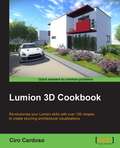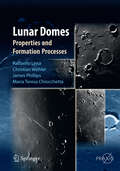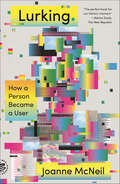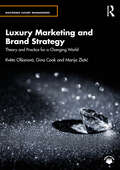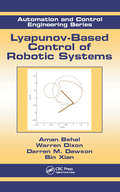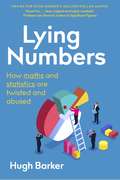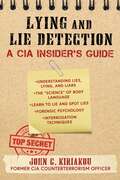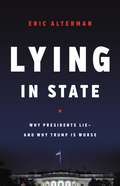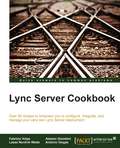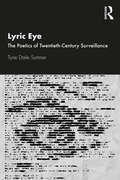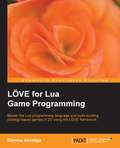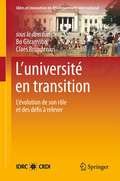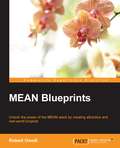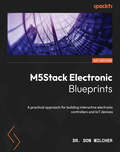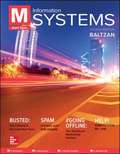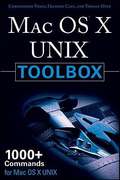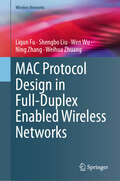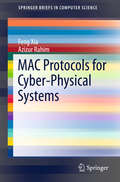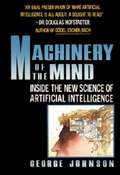- Table View
- List View
Lumion 3D Cookbook
by Ciro CardosoThis book offers uses practical applications using recipes with step-by-step instructions and useful information to help you master how to produce professional architectural visualizations in Lumion. The cookbook approach means you need to think and explore how a particular feature can be applied in your project and perform the intended task. This book is written to be accessible to all Lumion users and is a useful guide to follow when becoming familiar with this cutting-edge real-time technology.This practical guide is designed for all levels of Lumion users who know how to model buildings in 3D and a basic understanding of Lumion, who want to enhance their skills to the next level.
Lunar Domes: Properties and Formation Processes
by Christian Wöhler Jim Phillips Maria Teresa Chiocchetta Raffaello LenaLunar domes are structures of volcanic origin which are usually difficult to observe due to their low heights. The Lunar Domes Handbook is a reference work on these elusive features. It provides a collection of images for a large number of lunar domes, including telescopic images acquired with advanced but still moderately intricate amateur equipment as well as recent orbital spacecraft images. Different methods for determining the morphometric properties of lunar domes (diameter, height, flank slope, edifice volume) from image data or orbital topographic data are discussed. Additionally, multispectral and hyperspectral image data are examined, providing insights into the composition of the dome material. Several classification schemes for lunar domes are described, including an approach based on the determined morphometric quantities and spectral analyses. Furthermore, the book provides a description of geophysical models of lunar domes, which yield information about the properties of the lava from which they formed and the depth of the magma source regions below the lunar surface.
Lurking: How a Person Became a User
by Joanne McNeilOne of Esquire’s Best Books to Elevate Your Reading List in 2020, , and a OneZero Best Tech Book of 2020. Named one of the 100 Notable books of 2020 by the End of the World Review.A concise but wide-ranging personal history of the internet from—for the first time—the point of view of the userIn a shockingly short amount of time, the internet has bound people around the world together and torn us apart and changed not just the way we communicate but who we are and who we can be. It has created a new, unprecedented cultural space that we are all a part of—even if we don’t participate, that is how we participate—but by which we’re continually surprised, betrayed, enriched, befuddled. We have churned through platforms and technologies and in turn been churned by them. And yet, the internet is us and always has been.In Lurking, Joanne McNeil digs deep and identifies the primary (if sometimes contradictory) concerns of people online: searching, safety, privacy, identity, community, anonymity, and visibility. She charts what it is that brought people online and what keeps us here even as the social equations of digital life—what we’re made to trade, knowingly or otherwise, for the benefits of the internet—have shifted radically beneath us. It is a story we are accustomed to hearing as tales of entrepreneurs and visionaries and dynamic and powerful corporations, but there is a more profound, intimate story that hasn’t yet been told.Long one of the most incisive, ferociously intelligent, and widely respected cultural critics online, McNeil here establishes a singular vision of who we are now, tells the stories of how we became us, and helps us start to figure out what we do now.
Luv @ First Site (TodaysGirls.com #5)
by Terry Brown Tess KindigWhen Bren develops a crush on a new student, she lies to her friends and on a computer dating questionnaire in order to be matched with him.
Luxury Fashion Marketing and Branding: A Strategic Approach (Mastering Fashion Management)
by Alice DallabonaLuxury Fashion Marketing and Branding offers a comprehensive analysis of the key theories and concepts needed to understand the promotion of luxury fashion products. It covers subjects including luxury fashion retailing, digital marketing and communication, data analytics, emerging technologies, consumer behaviour and PR. The textbook also offers a focused discussion of the challenges faced by luxury fashion brands to meet growing customer demand for ethical and sustainable practice, including concerns related to diversity, inclusivity, and cultural sensitivity.This textbook is grounded in business practices, featuring real-world examples and international case studies from both established and modern brands. Chapter objectives and summaries aid comprehension, whilst end-of-chapter questions and activities enable further research and discussion.Luxury Fashion Marketing and Branding is ideal for advanced undergraduate and postgraduate students of fashion marketing and communications, luxury fashion business and luxury brand management. Its applied approach will also make it suitable for those studying for an Executive MBA in Fashion and Luxury Management. Online resources include an instructor’s manual, lecture slides and a test bank.
Luxury Marketing and Brand Strategy: Theory and Practice for a Changing World (Mastering Luxury Management)
by Květa Olšanová Gina Cook Marija ZlatićThis text provides a comprehensive and strategic overview of luxury marketing and brand management, guiding brands to balance tradition with innovation as they navigate modern challenges and seize opportunities in a rapidly evolving global market. The book explores the core aspects of luxury branding, including the defining traits of luxury brands, the dominance of major luxury groups and the resilience of independent brands with storied histories. It explores the delicate balance required to maintain a brand’s luxury status amidst evolving consumer expectations, technological advancements and sustainability concerns. Students will gain insight into innovative marketing strategies, from the use of NFTs and blockchain to the integration of AI and the metaverse in enhancing customer experiences. Offering a clear and engaging pathway through the complexities of luxury brand management, the authors draw on their extensive academic and professional experience, presenting a rich blend of theoretical insights and real-world global and cross-industry case studies from prestigious brands like Cartier, Van Cleef & Arpels, Chanel, Ferrari, Orient-Express and many others. This textbook is designed to be the cornerstone for advanced undergraduate and postgraduate courses in luxury marketing and luxury brand management. With a focus on the latest trends and future directions in luxury marketing, Luxury Marketing and Brand Strategy is not only an academic resource but also a practical guide for navigating and succeeding in the dynamic luxury market. Online resources include PowerPoint lecture slides for each chapter, sample answers for discussion questions, and a test bank. Please visit www.routledge.com/9781032973951.
Lyapunov-Based Control of Robotic Systems
by Warren Dixon Aman Behal Darren M. Dawson Bin XianLyapunov-Based Control of Robotic Systems describes nonlinear control design solutions for problems that arise from robots required to interact with and manipulate their environments. Since most practical scenarios require the design of nonlinear controllers to work around uncertainty and measurement-related issues, the authors use Lyapunov's direc
Lying Numbers: How Maths and Statistics Are Twisted and Abused
by Hugh BarkerA readily understandable exploration of how figures are badly reported or deliberately misrepresented everywhere from political arguments and briefings to business presentations and shopping offers.Praise for Hugh Barker's Million Dollar Maths:'Great fun. A clear, original and highly readable account of the curious relationship between mathematics and money.' Professor Ian Stewart - author of Significant Figures'A lively crash course in the mathematics of gambling, investing, and managing. Hugh Barker makes deep ideas fun and profitable.' William Poundstone - author of How to Predict the UnpredictablePoliticians, economists, scientists, journalists . . . all of them have been known to bend the truth and to twist the facts from time to time. But surely the numbers and statistics they rely on are cold, hard objective facts that tell the real story? Of course the truth is much murkier than that. Figures can be misinterpreted, misunderstood, misconstrued and misused in hundreds of different ways. This book takes a look at the many ways that statistical information can be badly reported or deliberately misused in all walks of life, from political arguments, to business presentations, to more local concerns such as shopping offers and utility bills. A polemical guide to how numbers are used to mislead, which is intended to help the reader through the minefield of dubious stats and lying numbers.
Lying Numbers: How Maths and Statistics Are Twisted and Abused
by Pocket Book of R Hugh BarkerA readily understandable exploration of how figures are badly reported or deliberately misrepresented everywhere from political arguments and briefings to business presentations and shopping offers.Praise for Hugh Barker's Million Dollar Maths:'Great fun. A clear, original and highly readable account of the curious relationship between mathematics and money.' Professor Ian Stewart - author of Significant Figures'A lively crash course in the mathematics of gambling, investing, and managing. Hugh Barker makes deep ideas fun and profitable.' William Poundstone - author of How to Predict the Unpredictable Politicians, economists, scientists, journalists . . . all of them have been known to bend the truth and to twist the facts from time to time. But surely the numbers and statistics they rely on are cold, hard objective facts that tell the real story? Of course the truth is much murkier than that. Figures can be misinterpreted, misunderstood, misconstrued and misused in hundreds of different ways. This book takes a look at the many ways that statistical information can be badly reported or deliberately misused in all walks of life, from political arguments, to business presentations, to more local concerns such as shopping offers and utility bills. A polemical guide to how numbers are used to mislead, which is intended to help the reader through the minefield of dubious stats and lying numbers.
Lying and Lie Detection: A CIA Insider's Guide
by John KiriakouA foolproof guide both to lying and to detecting deception,Lying and Lie Detection: A CIA Insider's Guide will teach you how the pros can tell if and when somebody is lying. People lie all the time. Studies show that the average American lies between six and twenty times a day. Most lies are of the &“little white&” variety or are meant to spare a person&’s feelings. But what about the big lies? What about the consequential ones? You have a right to know when somebody is lying to you. Now, imagine if you had the tools to spot a lie from the truth—a guide to perfect your sixth sense. Whether it's finding out if you truly got the job, unmasking an infidelity, or a simple recommendation, you will no longer have to spend hours, days, or even weeks pondering about it. Through the easy-to-follow instructions and professional anecdotes in Lying and Lie Detection: A CIA Insider's Guide, you&’ll learn to lie and spot lies from John Kiriakou, a former CIA counterterrorism officer and senior investigator for the Senate Foreign Relations Committee responsible for the capture of Abu Zubaydah.Remember, CIA operations officers are trained to lie. They lie all the time. When they are working undercover, they are actually living a lie. With the CIA as a teacher, you&’ll learn how to tell.
Lying in State: Why Presidents Lie -- And Why Trump Is Worse
by Eric AltermanThis definitive history of presidential lying reveals how our standards for truthfulness have eroded -- and why Trump's lies are especially dangerous.If there's one thing we know about Donald Trump, it's that he lies. But he's by no means the first president to do so. In Lying in State, Eric Alterman asks how we ended up with such a pathologically dishonest commander in chief, showing that, from early on, the United States has persistently expanded its power and hegemony on the basis of presidential lies. He also reveals the cumulative effect of this deception-each lie a president tells makes it more acceptable for subsequent presidents to lie-and the media's complicity in spreading misinformation. Donald Trump, then, represents not an aberration but the culmination of an age-old trend. Full of vivid historical examples and trenchant analysis, Lying in State is essential reading for anyone seeking to understand how we arrived in this age of alternative facts.
Lync Server Cookbook
by Fabrizio Volpe Alessio GiombiniIf you work with Lync on a daily basis or if you have to use a specific feature of Lync for a project, this is the book for you. For solutions architects, technical consultants, and administrators, if you have a Lync deployment and you want to upgrade, integrate, secure, or extend it to the cloud, you can get valuable information from the recipes in this book.
Lyric Eye: The Poetics of Twentieth-Century Surveillance
by Tyne Daile SumnerLyric Eye: The Poetics of Twentieth-Century Surveillance presents the first detailed study of the relationship between poetry and surveillance. It critically examines the close connection between American lyric poetry and a burgeoning U.S. state surveillance apparatus from 1920 to the 1960s. The book explores the myriad ways that poets—Ezra Pound, William Carlos Williams, W.H. Auden, Langston Hughes, James Baldwin, Sylvia Plath, Gertrude Stein, Robert Lowell, Allen Ginsberg and others—explored a developing and fraught environment in which the growing power of American investigative agencies, such as the FBI under J. Edgar Hoover, imposed new pressures on cultural discourse and personal identity. In analysing twentieth-century American poetry and its various ideas about "the self," Lyric Eye demonstrates the extent to which poetry and surveillance employ similar styles of information gathering such as observation, overhearing, imitation, abstraction, repurposing of language, subversion, fragmentation and symbolism. Ground-breaking and prescient, this book will be of great interest to scholars and researchers of literature, politics, surveillance and intelligence studies, and digital humanities.
LÖVE for Lua Game Programming
by Darmie AkinlajaThis book follows a tutorial approach with examples and step-by-step instructions to help explain the key concepts of the LÖVE framework as well as everything you need to know about game development using the Lua programming language.LÖVE2d for Lua Game Programming is for anyone who is interested in learning about desktop game development.
L’université en transition
by Bo Göransson Claes BrundeniusLa mondialisation, l'ère de l'information et l'essor de l'économie du savoir transforment profondément les modalités d'acquisition, de diffusion et de transformation du savoir. Il s'ensuit que la production du savoir a graduellement davantage à voir avec la compétitivité économique et y est plus directement liée. Ce nouvel état de fait signifie également que les universités se sentent de plus en plus poussées à s'adapter aux besoins de la société et de l'économie, qui évoluent sans cesse. En particulier, des pressions croissantes s'exercent sur les établissements d'enseignement supérieur et de recherche des pays industrialisés pour qu'ils définissent et affirment leur nouveau rôle au sein du système national d'innovation. Les établissements des pays en développement, quant à eux, sont appelés à définir le rôle qu'ils joueront afin de soutenir les structures émergentes du système d'innovation. Ce livre examine le rôle des universités et des instituts de recherche nationaux dans le développement économique et social. En réunissant des textes rendant compte d'initiatives et d'innovations dans diverses régions du monde, notamment en Chine, en Europe de l'Est, en Amérique latine, en Scandinavie, en Asie du Sud-Est, en Afrique subsaharienne et en Europe de l'Ouest, l'ouvrage brosse un tableau qui est d'actualité et qui intéressera tant les responsables des politiques et les administrateurs d'universités que les leaders économiques et sociaux et les chercheurs. Bo Göransson et Claes Brundenius sont tous deux affiliés au Research Policy Institute de l'Université de Lund, en Suède. M. Göransson est professeur agrégé et coordonnateur du programme LEAP4D, et M. Brundenius est professeur honoraire.
M.E.A.N. Blueprints
by Robert OnodiIf you are a web developer with a basic understanding of the MEAN stack, experience in developing applications with JavaScript, and basic experience with NoSQL databases, then this book is for you.
M5Stack Electronic Blueprints: A practical approach for building interactive electronic controllers and IoT devices
by Don WilcherAcquire hands-on knowledge and technical skills for designing and developing aesthetically appealing, interactive devices using ESP32, Arduino, and SNAP circuits with M5Stack CoreKey FeaturesLearn ESP32 microcontroller and M5Stack Core development platform with hands-on projectsCreate aesthetically appealing visuals for technology engagement using the M5Stack Core deviceBuild interactive devices using Arduino and SNAP circuits with the M5Stack Core development platformBook DescriptionAs an embedded systems developer or an IoT developer, you can often face challenges in maintaining focus on prototyping a product concept while using a specific high-level programming language for implementation. To overcome these challenges, the M5Stack Core platform uses an ESP32 microcontroller and block code that allows you to focus on product creation and application instead of the high-level programming language. M5Stack Electronics Blueprints presents various design and prototyping approaches as well as UI layout and electronics interfacing techniques that will help you to become skilled in developing useful products effectively. This book takes you through a hands-on journey for a better understanding of the ESP32 microcontroller and the M5Stack Core's architecture. You’ll delve into M5Stack Core topics such as electronic units, light, sound, motion devices, interfacing circuits, SNAP circuit kits, Arduino applications, and building Bluetooth and Wi-Fi IoT devices. Further, you’ll explore various M5Stack core applications using a project-based learning method, including the fascinating 32-bit microcontroller device technology. By the end of this book, you’ll be able to design and build interactive, portable electronic controllers, IoT, and wearable devices using the M5Stack Core.What you will learnDesign user interfaces using no-code/low code programming languagesPrototype electronic controllers for audio alarms swiftlyWire an M5Stack Core 2 to an Arduino Uno or equivalent to build a touch control relay controllerPrototype Bluetooth IoT controllers efficientlyBuild and code Wi-Fi sniffers and scanner gadgetsPrototype wearable devices with easeCreate ESP32 applications using system block diagram designBuild a DC motor controller operated by a M5Stack Core unitWho this book is forThis book is for practicing embedded systems and IoT developers, electronics and automation technicians, STEM technical educators, students, and hobbyists looking to learn about the ESP32 microcontroller and M5Stack technologies. There is no prerequisite – apart from a desire to learn about ESP32-based electronics and interactive devices, then this book is for you.
M5Stack Electronic Blueprints: A practical approach for building interactive electronic controllers and IoT devices
by Dr. Don WilcherAcquire hands-on knowledge and technical skills for designing and developing aesthetically appealing, interactive devices using ESP32, Arduino, and SNAP circuits with M5Stack CoreKey FeaturesLearn ESP32 microcontroller and M5Stack Core development platform with hands-on projectsCreate aesthetically appealing visuals for technology engagement using the M5Stack Core deviceBuild interactive devices using Arduino and SNAP circuits with the M5Stack Core development platformBook DescriptionAs an embedded systems developer or an IoT developer, you can often face challenges in maintaining focus on prototyping a product concept while using a specific high-level programming language for implementation. To overcome these challenges, the M5Stack Core platform uses an ESP32 microcontroller and block code that allows you to focus on product creation and application instead of the high-level programming language. M5Stack Electronics Blueprints presents various design and prototyping approaches as well as UI layout and electronics interfacing techniques that will help you to become skilled in developing useful products effectively.This book takes you through a hands-on journey for a better understanding of the ESP32 microcontroller and the M5Stack Core's architecture. You'll delve into M5Stack Core topics such as electronic units, light, sound, motion devices, interfacing circuits, SNAP circuit kits, Arduino applications, and building Bluetooth and Wi-Fi IoT devices. Further, you'll explore various M5Stack core applications using a project-based learning method, including the fascinating 32-bit microcontroller device technology.By the end of this book, you'll be able to design and build interactive, portable electronic controllers, IoT, and wearable devices using the M5Stack Core.What you will learnDesign user interfaces using no-code/low code programming languagesPrototype electronic controllers for audio alarms swiftlyWire an M5Stack Core 2 to an Arduino Uno or equivalent to build a touch control relay controllerPrototype Bluetooth IoT controllers efficientlyBuild and code Wi-Fi sniffers and scanner gadgetsPrototype wearable devices with easeCreate ESP32 applications using system block diagram designBuild a DC motor controller operated by a M5Stack Core unitWho this book is forThis book is for practicing embedded systems and IoT developers, electronics and automation technicians, STEM technical educators, students, and hobbyists looking to learn about the ESP32 microcontroller and M5Stack technologies. There is no prerequisite – apart from a desire to learn about ESP32-based electronics and interactive devices, then this book is for you.
M8.0 Wenchuan Earthquake
by Huilin Xing Xiwei XuThe M8.0 Wenchuan Earthquake occurred in China on May 12, 2008, killing over 69,000 people and displacing millions from their homes. This was one of the most catastrophic natural disasters on record. This book includes 5 chapters describing the tectonic setting and historical earthquakes around the Chuan-Dian region, the nucleation of the Wenchuan earthquake, occurrence and aftershocks. The field observations of earthquake induced surface fractures and building damage, form a major and special part of this book and include a large number of digital photos with accompanying explanantions.
M: Information Systems
by Paige BaltzanM: Information Systems provides the foundation that will enable students to achieve excellence in business, whether they major in operations management, manufacturing, sales, marketing, etc. M: Information Systems is designed to give students the ability to understand how information technology can be a point of strength in an organization.
MAC OS X Tiger in a Nutshell
by Andy LesterThe most popular and most complete desktop reference book on Mac OS X now covers Tiger! Apple's Mac OS X operating system continues to capture the attention of consumers and programmers alike with its ability to run older Mac programs, classic Unix applications, and innovative open source software. And the latest and greatest version, Mac OS X 10.4--otherwise known as "Tiger"--is more powerful and versatile (not to mention easier to use, faster, and better looking) than ever before. With unparalleled, up-to-the-minute detail on Tiger, Mac OS X Tiger in a Nutshell is loaded with new and updated material on practically every page. Sure, Mac OS X Tiger in a Nutshell covers all the essentials and most-talked-about new features of Tiger, including big-ticket items such as Spotlight for effortless searching, iChat AV for video conferencing, and Dashboard for one-click access to a calculator, weather reports, stock prices, flight times, and more. But this fully updated edition also covers the hundreds of nips and tucks Tiger made to its underlying technologies and existing applications, including improvements to graphics and the Unix-based core and an easy way to automate time-consuming, repetitive manual or batch tasks. Mac OS X Tiger in a Nutshell offers a wealth of detail about the new user-interface elements, system and network administration, and scripting and development. It covers enhancements to the Finder, Safari RSS, Mail 2, and System Preferences. This indispensable guide also includes the most complete Unix command reference found in print--each command and option has been painstakingly tested and checked against Tiger. Even the manpages that ship with the system can't compete in accuracy! For longtime Mac loyalists as well as recent converts, for consumers, developers and programmers, this fully updated edition provides the perfect overview of Mac OS X and all the nitty-gritty hints and how-tos you need to make it your all-purpose, must-have Tiger guide.
MAC OS X UNIX Toolbox
by Christopher NegusExplore a ton of powerful Mac OS X UNIX commands This handy, compact guide teaches you to use Mac OS X UNIX systems as the experts do: from the command line. Try out more than 1,000 commands to find and get software, monitor system health and security, and access network resources. Apply the skills you learn from this book to troubleshoot networks, lock down security, and uncover almost anything you care to know about your Mac OS X system. Expand your Mac OS X UNIX expertise in these and other areas: Using the shell Finding online software Working with files Playing with music and images Administering file systems Backing up data Checking and managing running processes Accessing network resources Handling remote system administration Locking down security
MAC Protocol Design in Full-Duplex Enabled Wireless Networks (Wireless Networks)
by Weihua Zhuang Ning Zhang Wen Wu Liqun Fu Shengbo LiuThis book thoroughly examines the design of full-duplex medium access control (MAC) protocols in wireless networks. It is organized into three main sections: (a) Fundamentals and preliminaries of full-duplex communications, (b) A comprehensive review of the existing full-duplex MAC protocols, and (c) Designs of full-duplex MAC protocols in three typical wireless networks, i.e., wireless local access networks (WLANs), multi-hop networks and millimeter-wave networks. Also, the authors extensively address key challenges in these three wireless full-duplex networks, such as the hidden-node problem, accumulative interference, and deafness and blockage problems. Solutions to these challenges are meticulously devised to enhance the overall network performance. The wireless full-duplex communication technique, facilitating simultaneous transmission and reception within the same frequency band, holds immense potential for enhancing spectrum efficiency and network capacity. It emerges as a pivotal technology in the sixth-generation (6G) networks. This book provides a comprehensive review and in-depth exploration of full-duplex MAC design across various networks, encompassing WLANs, multi-hop networks, and millimeter-wave networks. Acknowledging the challenges faced by full-duplex WLANs, particularly the hidden-node problem, it also introduces a pioneering hidden-node-free design and a MAC protocol design, which features a full-duplex enhanced carrier-sensing mechanism. Addressing the need to augment end-to-end throughput in multi-hop networks employing full-duplex relaying, the authors present an analytical model for end-to-end throughput and propose a multi-hop full-duplex MAC protocol designed to optimize network performance. Furthermore, the exploration extends to full-duplex millimeter-wave networks, delving into issues of deafness and blockage. A directional full-duplex MAC protocol is introduced to enhance network capacity and mitigate blockage problems. This book concludes by outlining prospective research directions within the related fields of study and offers valuable insights for future exploration. This book targets researchers and advanced level students in computer science and electrical engineering. It also caters to professionals engaged in the fields of wireless networks, full-duplex system, protocol design, and network optimization will also buy this book.
MAC Protocols for Cyber-Physical Systems
by Feng Xia Azizur RahimThis book provides a literature review of various wireless MAC protocols and techniques for achieving real-time and reliable communications in the context of cyber-physical systems (CPS). The evaluation analysis of IEEE 802. 15. 4 for CPS therein will give insights into configuration and optimization of critical design parameters of MAC protocols. In addition, this book also presents the design and evaluation of an adaptive MAC protocol for medical CPS, which exemplifies how to facilitate real-time and reliable communications in CPS by exploiting IEEE 802. 15. 4 based MAC protocols. This book will be of interest to researchers, practitioners, and students to better understand the QoS requirements of CPS, especially for healthcare applications.
MACHINERY OF MIND: Inside the New Science of Artificial Intelligence
by George JohnsonAn extensive treatment of the history, content, politics, and philosophy of the new computer science subdiscipline of Artificial Intelligence (AI).
